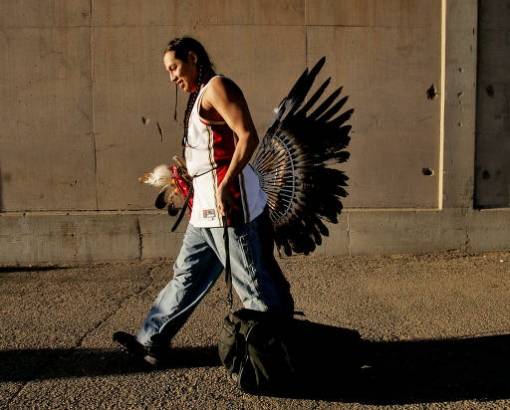If you were asked to picture a modern American Indian in your head, what's the first image that pops into your mind? If you're like most of us, you probably pictured a person living on a reservation in a far flung corner of a Western or Midwestern state.
That image, however, is far from accurate. According to the most recent US Census, as reported on by the New York Times, approximately 70 percent of all those identify as Indians and Alaska Natives are currently residing in metropolitan areas. By way of perspective, only about 45 percent of Indians and Alaska Natives lived in metropolitan areas as recently as 1970.
That Indians and Alaska Natives left reservations and headed for big cities and suburbs was no accident. During the mid-20th century, the Federal Government strongly encouraged Indians to stake out new lives in urban areas. The program, which operated under the Indian Relocation Act of 1956 or Adult Vocational Training Program, offered incentives such as job training and help with relocation costs for Indians who were willing to move off of reservations.
According to the Bureau of Indian Affairs, more than 31,000 Indians participated in the program and approximately 70 percent of those participants were "self-sufficient" by 1960.
While living on a reservation has its share of challenges, it does offer a built-in support network that many Indians have had trouble finding in sprawling urban environments. In fact, many of the problems that can scar reservation life have followed Indians to the city.
For example, the US Census reports that a full 28 percent of Indians live in poverty, compared with a nationwide average of just 15 percent. For urban Indians, that rate is only slightly lower at 25 percent.
Though the Bureau of Indian Affairs' (BIA) stated mission is to, "… enhance the quality of life, to promote economic opportunity, and to carry out the responsibility to protect and improve the trust assets of American Indians, Indian tribes, and Alaska Natives," that mission hasn't moved from reservation to metropolis. As of 2014, only a very small fraction of its efforts are currently pointed towards urban Indians.
Many cities, including Denver, have attempted to close that gap by opening their own offices dedicated to the needs of urban Indians. In Denver, that work is done by the Denver American Indian Commission.
Despite what seems like a cavalcade of depressing statistics, urban American Indians and Alaska Natives are finding success in urban areas, particularly in Denver. According to a Sept.19, 2004 Denver Post article, Denver has become a, "...mecca for national Indian institutions."
The article points out that about a dozen or so American Indian institutions of national prominence are headquartered in Denver. These include the Native American Fish and Wildlife Society and the Native American Bank. Other American Indian institutions, like the Native American Sports Council and Native American Rights Fund, make their homes in other Colorado metropolitan areas.
American Indians have always been a very dynamic and diverse group that are impossible to pigeonhole into one demographic sketch. This observation is equally applicable to both urban and reservation Indians. Hopefully, local governments and tribal leaders will endeavor to provide leadership and services that help them thrive, no matter where they're living.


Comments
Visit www.homeofwhitebuffalo
Visit www.homeofwhitebuffalo.org A vehicle with the intent to empower Native Americans by establishing a dinner theater in Denver Colorado. Would like to hear from you.
Add new comment